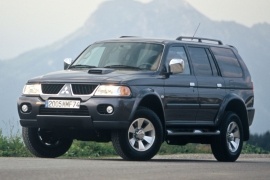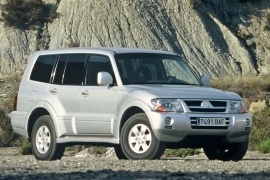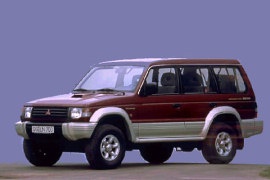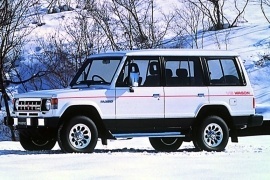
MITSUBISHI Pajero 5 Doors
Generations Timeline, Specs and Pictures

Mitsubishi was the most notorious competitor in the harsh Paris-Dakar Rallye-raid, which it won 12 times with the Pajero.
The street version also won a reputation for reliability.
The Pajero, which was also known as Montero in Spain and other Spanish-speaking countries, or Shogun in the U.K. started its journey in 1981 with the first generation. It was a body-on-frame construction. The third generation was introduced in 1999 with revolutionary unibody construction and an integrated ladder frame chassis. That construction type was carried over to the fourth generation, which was launched in 2006 at the Paris Motor Show.
The flared wheel arches and the sloped roofline were unusual for a true off-road vehicle. A three-slat chromed grille was introduced and bigger, taller headlights were installed. It was offered in a 3-, and 5-door version. The former was offered as a 5-seat only and the later was fitted with 7 seats. The spare-wheel was kept on the rear trunk door.
Inside, the Pajero featured a newly designed dashboard, with a big instrument cluster. The center stack hosted the infotainment unit and an additional LCD for the on-board computer. There was plenty of room for three adult passengers on the middle row and limited for the third.
The technical platform was the one that brought the Pajero under spotlights. It was the only 4x4 vehicle in the world that featured a 4x4 on-demand system which could have been driven as an all-wheel-drive vehicle since it was fitted with three differentials. The central and the rear one could have been locked for better traction. For the engine bay, the manufacturer installed either a 3.2-liter turbocharged diesel or 3.8-liter gasoline. Both versions were mated as standard with a 5-speed manual, while a 5-speed automatic was available as an option.

With the Pajero/Montero/Shogun name attached, this chassis-based Mitsubishi was one of the last vehicles built by the Japanese car-maker on a light-utility vehicle.
The Shogun Sport was offered with the name Montero or Pajero depending on the market where it was offered. It featured a small body on a high chassis taken from the Mitsubishi L200 pickup truck. But there was a different bodywork and, of course, a different interior.
The styling resembled the one from the L200, but with a different front fascia. It did, somehow, have a look of a station-wagon on stilts since it didn’t have the spare wheel in the back. It was under the trunk. With its small windows and straight roofline, it looked faster than it actually was.
Inside, the Pajero/Shogun/Montero Sport featured plastic wooden trims, plastic dashboard and interior door panels. The center console was made out of plastic as well. Despite its long cabin, it was available as a 5-seat only. The rear seat passengers didn’t have too much legroom, but it was fair even for above-average ones.
For the engine, the most common unit found under the hood was a 2.5-liter turbodiesel mated to a standard 5-speed manual. A low-range stick was next to it. Unlike its bigger brother, the Pajero/Montero/Shogun SUV, it didn’t feature the intelligent traction system with three differentials. It was fitted with a classic 4x4 on-demand system with either rear or all-wheel drive without a center differential. But at least it was fitted with a limited-slip differential. An automatic version was available as well and, on some specific markets, a 3.0-liter V6 unit.

Having increased road stability and ride comfort due to a significant size increase over the short-wheelbase model, the third generation LWB was launched in 1999 and restyled in 2003.
Aimed at dethroning the Land Rover Discovery and stopping Toyota Land Cruiser’s rapid expansion, the 2003 model offered as many free extra options as the base price tag would allow it. following the introduction of the new 3.8 L V6 unit, Mitsubishi has also made other under-bonnet adjustments: the 3.0 L saw a power output decrease while the 3.5 L plant received a horse power boost, reaching a top 217 thanks to having been equipped with a gasoline direct injection system.

The third generation of the Pajero/Montero/Shogun was the most significant change made by Mitsubishi in the vehicle lineup.
After two generations built on a ladder chassis, the third generation came with a completely new approach. The carmaker noticed that most customers used their Pajero/Montero/Shoguns on paved streets, and they asked for comfort. Thus, it made the 2000 model with unit-body construction and independent suspension in all corners. Moreover, the carmaker added the most advanced 4x4 system on the market, with three differentials and the possibility to drive the car with rear-wheel-drive only.
The rounded shapes of the third generation replaced the boxy shapes of its predecessor. Also, it increased its size in order to accommodate a roomier interior. Its flared arches, both front, and rear were inspired by sumo-fighters, but the headlights remained squared.
Inside, the Mitsubishi installed a seven-seat interior in a 2-3-2 configuration. The last row of seats was either stow-away or removable, while the second row was split-folding. Only the front seats were regular and unremovable. The dashboard was tall, with a distinct center stack where the carmaker placed the audio and climate controls, plus a small LCD at the top for the trip computer.
Depending on the market, the Montero featured a fuel-efficient range of diesel engines or a V-6 gasoline unit.

Mitsubishi introduced the all-new second generation of the Pajero/Montero/Shogun in 1991 in Japan and started selling it on other markets a year later.
Named differently on specific markets, the Pajero/Montero/Shogun received a significant update. While it was still a body-on-frame construction, it featured advanced technologies for its time. Mitsubishi aimed at Toyota’s Land Cruiser and had to struggle hard to get a grip on its main competitor’s market.
The 1992 Pajero featured a flat front fascia with big squared headlights and corner-mounted turn signals and parking lights, losing the round headlights of its predecessor. Its slightly tilted grille sported three horizontal slats and, depending on the trim level, adorned with chromed accents. The plastic, wrapped-around bumpers were continued on the sides by side moldings over the wheel arches and door panels to the car’s back. At the back, the carmaker installed the spare wheel on the side-hinged trunk door.
Inside, depending on the trim level, it featured either a cloth or a leather-clad interior. Its angular-shaped dashboard sported an instrument panel in front of the driver and a second one above the center stack. While the former showed the usual information regarding speed, revs, and engine status, the latter showed the car’s pitch and roll angle, a compass, and an altimeter. The cabin could host five or seven occupants, with a pair of jump seats in the trunk.
Under the hood, Mitsubishi installed a choice of gasoline or turbo-diesel engines. A significant upgrade was the Super Select transmission, which allowed the driver to drive the car with rear-wheel drive, or all-wheel-drive with three differentials and featured a standard center differential lock. A two-speed transfer case was also standard on all Pajero models.

Launched in 1983 in response to the mixed reactions sparked by the short-wheelbase Pajero release, the 5-door version came with increased seating and cargo capacity.
Aimed at appealing to a a larger target consumer group, the Pajero was a vehicle with a flexible interior that could be arranged in a variety of configurations to either provide comfortable seating for 7, sleeping space or generous storage area. Powered by the same range of engines, the Pajero later saw minor engine upgrades as well as the introduction of four wheel brakes and adjustable shock absorbers as standard equipment.

Mitsubishi introduced the first generation of the Pajero/Montero/Shogun lineup in 1981, and soon it was noticed as an excellent offroad vehicle.
In 1983, the Japanese carmaker introduced a long-wheelbase version with five doors that extended the Montero range. Unlike other 4x4 vehicles on the market, Mitsubishi offered the car with three roof variations: standard, semi-high, and high-roof. Moreover, the five-door version was a better bet for those who needed more room for rear passengers, which stood cramped in the three-door version.
The addition of a five-door version transformed the Pajero into a family SUV. Its three side windows and long roof made the vehicle looks more balanced. Mitsubishi built the Montero as a tough offroad vehicle and installed heavy-duty skid plates under the engine and transmission to protect them. Customers could found tow hooks both at the front and rear of the car, and the carmaker offered a bush-guard as an option. The carmaker kept the round headlights in squared clusters while the corner-mounted turn signals and parking lights were better protected than the one fitted on the bumper.
Inside, the Montero offered room for five tall passengers. On the high-roof version, they could wear tall-hats without any troubles at all. Its folding bench enlarged the trunk area from 43.4 cu-ft (1,229 liters) to 94.9 cu-ft (2,687 liters). For the dashboard, Mitsubishi added a cluster with an inclinometer and gauges for amps and oil pressure.
Under the hood, depending on the market. Mitsubishi introduced a new 2.6-liter gasoline engine and paired it with an optional four-speed automatic transmission, while the 2.3-liter turbo-diesel was replaced by a de-tuned version of the 2.5-liter unit.























































